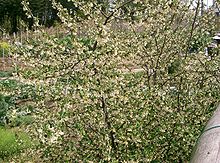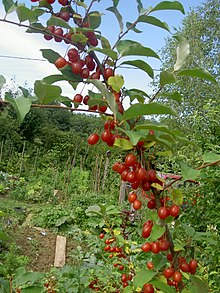Complainer (talk | contribs) Undid revision 554143590 by Sminthopsis84 (talk) No, I don't. Removing unsourced information is a discretionary power of any wikipedia editor, and looking for sources is not a duty. |
Sminthopsis84 (talk | contribs) source |
||
| Line 21: | Line 21: | ||
As with other species in the genus ''Elaeagnus'', ''E. multiflora'' plants are [[actinorhizal plant|actinorhizal]], growing in [[symbiosis]] with the [[actinobacteria|actinobacterium]] ''[[Frankia]]'' in the soil. These bacteria fix atmospheric [[nitrogen]], making it available in usable form for the host plant, and indirectly for other nearby plants. This feature allows the plant to grow in poorer soils than it could otherwise. |
As with other species in the genus ''Elaeagnus'', ''E. multiflora'' plants are [[actinorhizal plant|actinorhizal]], growing in [[symbiosis]] with the [[actinobacteria|actinobacterium]] ''[[Frankia]]'' in the soil. These bacteria fix atmospheric [[nitrogen]], making it available in usable form for the host plant, and indirectly for other nearby plants. This feature allows the plant to grow in poorer soils than it could otherwise. |
||
[[China|Chinese]] people have traditionally considered ''Elaeagnus multiflora'' to be among a group of "[[nutraceutical]]s", or foods that are edible and have medicinal values.<ref>{{cite book|author=MobileReference|year=2008|title=The Illustrated Encyclopedia of Trees and Shrubs: An Essential Guide to Trees and Shrubs of the World|publisher=MobileReference.com|isbn=9781605014876|url=http://books.google.ca/books?id=mZEhZMOFLiQC|}}</ref> |
|||
This species is occasionally grown in [[Europe]] and [[North America]] as an [[ornamental plant]] and for its fruit. It is an [[naturalisation (biology)|established exotic species]] in parts of the eastern [[United States]] [http://plants.usda.gov/java/profile?symbol=ELMU]. |
This species is occasionally grown in [[Europe]] and [[North America]] as an [[ornamental plant]] and for its fruit. It is an [[naturalisation (biology)|established exotic species]] in parts of the eastern [[United States]] [http://plants.usda.gov/java/profile?symbol=ELMU]. |
||
Revision as of 21:45, 8 May 2013
| Elaeagnus multiflora | |
|---|---|

| |
| Scientific classification | |
| Kingdom: | |
| (unranked): | |
| (unranked): | |
| (unranked): | |
| Order: | |
| Family: | |
| Genus: | |
| Species: | E. multiflora
|
| Binomial name | |
| Elaeagnus multiflora | |
Elaeagnus multiflora (Goumi, Gumi, Natsugumi, or Cherry silverberry), is a species of Elaeagnus native to China, Korea, and Japan.
Elaeagnus multiflora is a deciduous or semi-evergreen shrub or small tree growing to 2-8 m tall, with a trunk up to 30 cm diameter with dark brown bark. The shoots are densely covered in minute red-brown scales. The leaves are ovate to elliptic, 3-10 cm long and 2-5 cm broad, green above, and silvery to orange-brown below with dense small scales.
The flowers are solitary or in pairs in the leaf axils, fragrant, with a four-lobed pale yellowish-white corolla 1.5 cm long; flowering is in mid-spring.


The fruit is round to oval drupe 1 cm long, silvery-scaled orange, ripening red dotted with silver or brown, pendulous on a 2-3 cm peduncle. When ripe in mid- to late summer, the fruit is juicy and edible, with a sweet but astringent taste somewhat similar to that of rhubarb. The skin of the fruit is thin and fragile, making it difficult to transport, thus reducing its viability as a food crop.
As with other species in the genus Elaeagnus, E. multiflora plants are actinorhizal, growing in symbiosis with the actinobacterium Frankia in the soil. These bacteria fix atmospheric nitrogen, making it available in usable form for the host plant, and indirectly for other nearby plants. This feature allows the plant to grow in poorer soils than it could otherwise.
Chinese people have traditionally considered Elaeagnus multiflora to be among a group of "nutraceuticals", or foods that are edible and have medicinal values.[1]
This species is occasionally grown in Europe and North America as an ornamental plant and for its fruit. It is an established exotic species in parts of the eastern United States [1].
References
- Germplasm Resources Information Network: Elaeagnus multiflora
- Japan Tree Encyclopaedia: Natsugumi (Elaeagnus multiflora)
- Plants for a Future: Elaeagnus multiflora
- USDA Natural Resources Conservation Service: PLANTS Profile for Elaeagnus multiflora (cherry silverberry)
External links
- ^ MobileReference (2008). The Illustrated Encyclopedia of Trees and Shrubs: An Essential Guide to Trees and Shrubs of the World. MobileReference.com. ISBN 9781605014876.
{{cite book}}: Cite has empty unknown parameter:|1=(help)
Well, that’s interesting to know that Psilotum nudum are known as whisk ferns. Psilotum nudum is the commoner species of the two. While the P. flaccidum is a rare species and is found in the tropical islands. Both the species are usually epiphytic in habit and grow upon tree ferns. These species may also be terrestrial and grow in humus or in the crevices of the rocks.
View the detailed Guide of Psilotum nudum: Detailed Study Of Psilotum Nudum (Whisk Fern), Classification, Anatomy, Reproduction